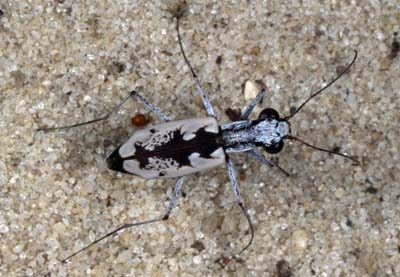
Adult Cicindela hirtilabris, a tiger beetle.
(Photographer: Lyle Buss, University of Florida)
Tiger beetles are active, agile insects that hunt their prey in sunny, open areas. Male and female tiger beetles of the same species are similar in appearance. They are metallic in color or iridescent, and have particular color patterns with no ridges. Tiger beetles are commonly recognized by their shape. The abdomen is oval, slender and tapers at the posterior end in a triangular fashion. The width of the head at the eyes is as wide, or wider, than the thorax.
Adult male and female tiger beetles emerge during the summer. After mating, female tiger beetles lay their eggs in shallow holes dug in the soil. Upon hatching, the larvae construct vertical tubes in which they will live and eventually pupate. The larvae are s-shaped and contain dorsal abdominal hooks that are used to maintain their position in the burrows. Larval burrows can be as deep as 100 cm, but in Florida they rarely exceed 30 cm.
Tiger beetles are found throughout the United States in sand scrub habitats, ocean beaches, along wooded paths, in disturbed areas, along sidewalks, in open pastures, in mudflats, dunes, rocky outcroppings and in dry soils.
These beetles feed on larvae of various insects, and other small arthropods.
Images
To save the Web-optimized images shown below to your hard drive:
|
Click to access Display and Print quality images. |
|
Click to access Display and Print quality images. |
|
Click to access Display and Print quality images. |
|
Click to access Display and Print quality images. |